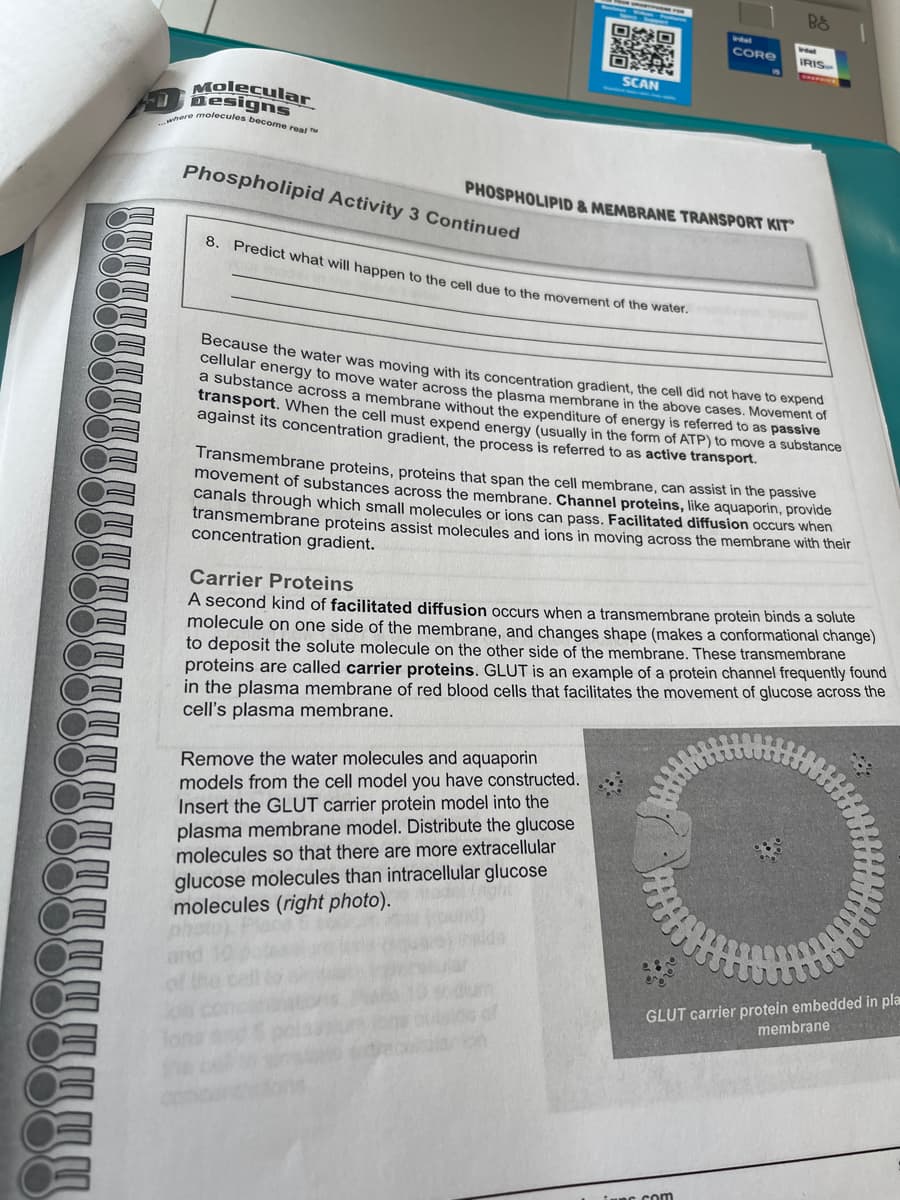Biology (MindTap Course List)
11th Edition
ISBN:9781337392938
Author:Eldra Solomon, Charles Martin, Diana W. Martin, Linda R. Berg
Publisher:Eldra Solomon, Charles Martin, Diana W. Martin, Linda R. Berg
Chapter5: Biological Membranes
Section: Chapter Questions
Problem 7TYU: Test Your Understanding 7.In cotransport (indirect active transport) (a) a uniporter moves a solute...
Related questions
Question
Please see the picture below

Transcribed Image Text:000000000
Mesionar
where molecules become real™
Phospholipid Activity 3 Continued
90
KLA
OXCA
SCAN
PHOSPHOLIPID & MEMBRANE TRANSPORT KIT
8. Predict what will happen to the cell due to the movement of the water.
Instal
CORE
Remove the water molecules and aquaporin
models from the cell model you have constructed.
Insert the GLUT carrier protein model into the
plasma membrane model. Distribute the glucose
molecules so that there are more extracellular
glucose molecules than intracellular glucose
molecules (right photo).
Bo
Because the water was moving with its concentration gradient, the cell did not have to expend
cellular energy to move water across the plasma membrane in the above cases. Movement of
a substance across a membrane without the expenditure of energy is referred to as passive
transport. When the cell must expend energy (usually in the form of ATP) to move a substance
against its concentration gradient, the process is referred to as active transport.
IRIS
Transmembrane proteins, proteins that span the cell membrane, can assist in the passive
movement of substances across the membrane. Channel proteins, like aquaporin, provide
canals through which small molecules or ions can pass. Facilitated diffusion occurs when
transmembrane proteins assist molecules and ions in moving across the membrane with their
concentration gradient.
Carrier Proteins
A second kind of facilitated diffusion occurs when a transmembrane protein binds a solute
molecule on one side of the membrane, and changes shape (makes a conformational change)
to deposit the solute molecule on the other side of the membrane. These transmembrane
proteins are called carrier proteins. GLUT is an example of a protein channel frequently found
in the plasma membrane of red blood cells that facilitates the movement of glucose across the
cell's plasma membrane.
juns com
GLUT carrier protein embedded in pla
membrane
Expert Solution
This question has been solved!
Explore an expertly crafted, step-by-step solution for a thorough understanding of key concepts.
Step by step
Solved in 2 steps

Knowledge Booster
Learn more about
Need a deep-dive on the concept behind this application? Look no further. Learn more about this topic, biology and related others by exploring similar questions and additional content below.Recommended textbooks for you

Biology (MindTap Course List)
Biology
ISBN:
9781337392938
Author:
Eldra Solomon, Charles Martin, Diana W. Martin, Linda R. Berg
Publisher:
Cengage Learning

Biology (MindTap Course List)
Biology
ISBN:
9781337392938
Author:
Eldra Solomon, Charles Martin, Diana W. Martin, Linda R. Berg
Publisher:
Cengage Learning